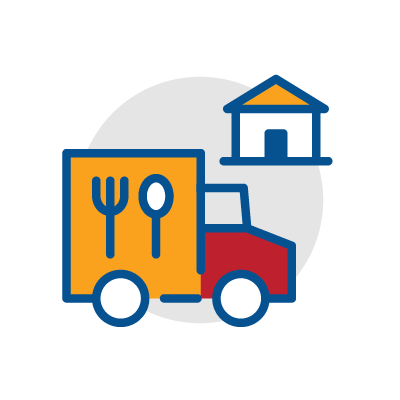 Basics of Home-Delivered Meals
Basics of Home-Delivered Meals
Home-delivered meal programs provide nutritious meals to older adults who are not able to attend congregate meal sites. For those who are unable to consume meals at the congregate site, delivery of these meals by nutrition staff and volunteers provides an opportunity to see a friendly face. Discover new strategies to support and enhance your home-delivered meal program.
 Briefs
Briefs
- Nutrition Services of the Older Americans Act — Overview of nutrition services authorized
by the OAA, including eligibility, purpose, definitions, standards, and outcomes (ACL) - What We Deliver— Fact sheet highlighting participant stories and program impact using infographics, data insights, and brief video content (Meals on Wheels America, 2025)
- Person-Centered Dining Choices — Tips for determining which dining options best
meet individual participant needs (Nutrition and Aging Resource Center, 2024) - Communicating Effectively with People with Disabilities— Communication solutions that
fit different situations to ensure equal access and understanding (ADA.gov)
 Quick Guides
Quick Guides
- Delivery Logistics: Questions To Consider — FAQs for creating an effective delivery model (Nutrition and Aging Resource Center)
- Plating Tips for Your Home-Delivered Meals Program — Tips on serving attractive plating for home-delivered meals (Nutrition and Aging Resource Center)
- Quick Tips: Home-delivered Meals — Information and resources related to common questions about
OAA Title III-C2 Home-delivered meals (Nutrition and Aging Resource Center, 2023) - Quick Tips: Funding Options — Information and resources related to common questions on funding for OAA Title III-C Nutrition Services (Nutrition and Aging Resource Center, 2023)
 Guides
Guides
- Food Freezing Basics— Best practices to maintain the quality of frozen foods (North Dakota State University)
- How Meals on Wheels is Funded— Funding sources for programs using federal, state, local, and private dollars (Meals on Wheels America, 2020)
- Shelf Stable Food Safety— Comprehensive guide to shelf-stable food safety, including preservation methods, key terminology, packaging standards, and storage practices (USDA)
 Toolkits
Toolkits
- Help Your Local Meals On Wheels Program Ditch Disposables— Tools to help meal programs make the switch from disposable to reusable (Beyond Plastics)
- Determine Your Nutritional Health — Screening tool to help assess nutritional risk (Nutrition Screening Initiative)
- Dietary Guidelines for Americans and Older Adults Toolkit — Resource to help senior nutrition programs develop policies to meet OAA requirements (Nutrition and Aging Resource Center)
- Local and National Shelf Stable/Frozen Meals Vendor Template — Blank template to help programs provide participants with tailored listings of meals that meet their needs (Nutrition and Aging Resource Center)

